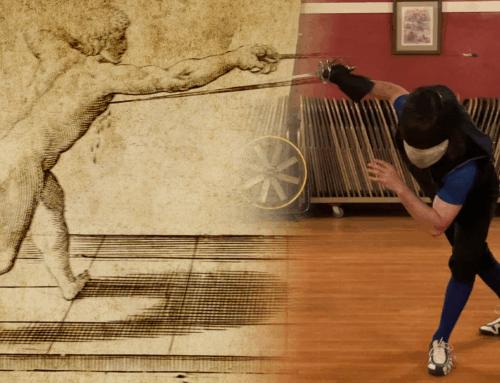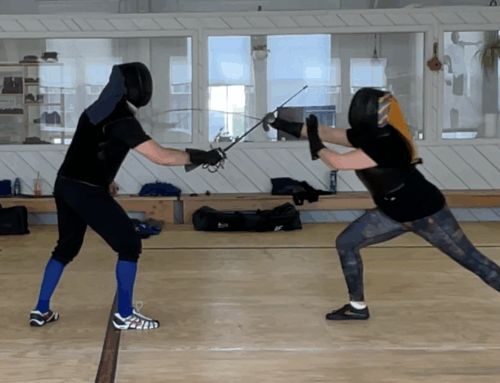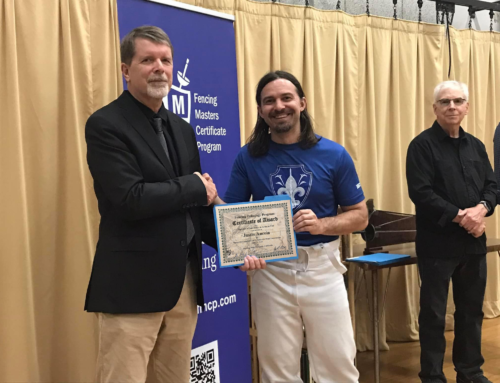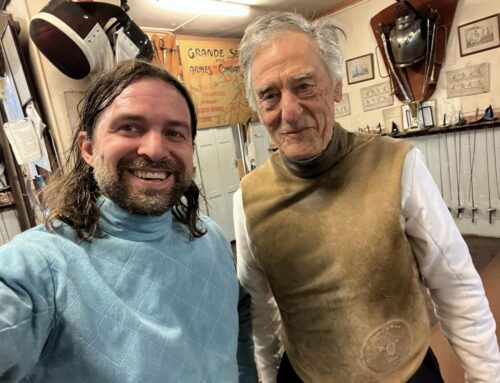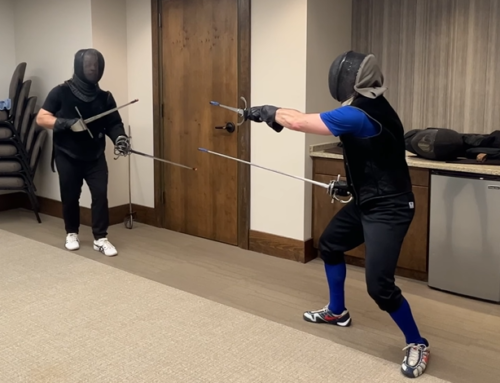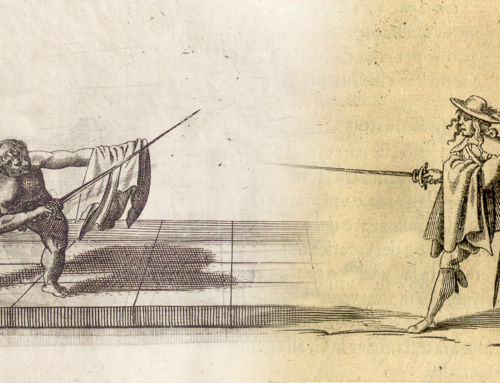Today we’ll be looking at the plays in Plate 9 of La Scherma by Francesco Ferdiando Alfieri. You can snag a copy over on Amazon if you want to follow along.
You can also find the rest of my Alfieri & other historical rapier research over in the Historical Fencing section.
This chapter is going to bit of a hot mess, thanks to Alfieri’s lack of details in this manual, specifically what the wounded fencers do in the plays. So strap yourself in ’cause this is gonna be a bumpy ride.
The Setup
Alfieri leads off by mentioning how small mistakes can turn into huge advantages for your opponent.
Gentleman 16 started off in terza while Gentleman 17 approached defensively in guardia mista and feints to the outside line above the sword. Instead of attacking in tempo, Gentleman 16 has “quickly gone into obedience” to defend against the attack.
The Problems… aka this Chapter Translation is a Hot Mess
I’m running into a few issues with this chapter’s text & plate.
The first problem is the text says to approach in guardia mista but then feint on the outside line. In Part 1, Alfieri defines guardia mista as being a guard between terza and quarta making it more of an inside line guard. It doesn’t make sense to use it on the outside line.
The second problem we’re going to run into is what “gone into obedience” means. It’s a vague sounding phrase that doesn’t really provide any imagery or details into how Gentleman 16 screwed up. Did he use the wrong guard? Bad tempo? Both? Something else?
So I took the original text and dumped it into Google Translation. Obviously, Google Translate is really hit or miss, but I was hoping for some insight since I don’t know Italian.
Se ne stava il Cavaliere 16. in Terza, e postosi nella diffesa, s’è mosso il feritore ad assalirlo in Guardia Mista, e giunto con ogni cautela in misura, l’ha chiamato con una Finta per difuora sopra la Spada, il quale in vece di tirar nel tempo della Finta se n’è subbito andato all’obbedienza per riparare la botta, onde l’avversario 17. che l’ha condotto con artifizio al termine pensato, ha guadagnate sopra di esso tre vie da poterlo colpire.
The knight was in the Third, and in the diffused position, he moved the wounded man to assail him in the Mixed Guard, and, coming with every measure of caution, called him with a Pretend to defend himself above the Sword. instead of tugging at the time of the Fake, he went to obedience to repair the blow, so that the opponent 17 who led him with artifice at the thought of the term, gained three ways to strike him.
Unsurprisingly, not a ton of insight. If someone who knows Italian better than myself and Google can shed some light, that would be pretty awesome.
This chapter and it’s supplemental plate make much more sense if the play starts on the inside line like in Chapter XIII. It makes the two chapters similar, but the end sword position is different. With that in mind, and after conferring with some fellow historical fencer friends, I’m going to say that the translation is in error and that the play should start with guardia mista on the inside line.
Back to the plate, Gentleman 17 can wound Gentleman 16 in three ways from here…
The Plays
Play #1. With Gentleman 17 having feinted on the inside line, Gentleman 16 moves to parry. Gentleman 17 performs a cavazione to the outside line and strikes Gentleman 16 under sword arm/chest in seconda while performing a passing step. Gentleman 17’s off hand reaches for Gentleman 16’s hilt to keep from being hit post-attack and/or to disarm.
This is identical to Play #2 in Chapter XIII. It also is similar to Play #3 in Chapter XII, but in Chapter XII the attack is done with a firm footed lunge.
Play #2. Gentleman 17 again feints to the inside line in guardia mista. Gentleman 16 bites and goes for the parry. Gentleman 17 disengages and strikes in seconda on the high outside line with a firm foot (aka a lunge) along Line A.
This is an identical play as to the first play in Chapter XII.
Note: The final action of this play’s text doesn’t match the accompanied artwork, but the artwork should be seen as supplementary. The text should be given more weight than any image in the treatise.
Play #3. The translation reads to feint on the outside along Line A. Gentleman 16 would then have to move to parry the feint. Gentleman 17 can then perform a cavazione to the inside line and perform a mandritto to Line B on Gentleman 16’s leg.
This third plate I’m not 100% sure on. The first two plays build off the feint in guardia mista but this play has Gentleman 17 also performing a feint on the outside line. So is Gentleman 17 performing two cavaziones — originally on the inside line (like in the plate setup) and then another listed in the paragraph? Or is it an altogether new play that begins with a feint to the outside along Line A?
Alternately, it could be another translation error and perhaps the feint is on the inside along Line A (still in guardia mista like in the setup). As Gentleman 16 goes to parry the feint Gentleman 17 could drop his sword and cut with a mandritto while passing with the left foot.
How the mandritto is performed would look different between the two but it seems more efficient and natural in my second scenario for Play #3 — a feint to the inside along Line A and then dropping the sword to cut along Line B. The offhand would still reach out to grasp the hilt of Gentleman 16.
Kron Rapier Group’s Interpretation
Above is the Kron Rapier Group’s interpretation of Plate 9. They’re working off an earlier edition of the translated manual, which apparently also was written as having a feint used on the outside line to start off the play.
And while I 100% understand why they’re doing that and how they got to where they got in this plate, I got a few issues with their interpretation:
- How/why are they interpreting “gone into obedience” as a really poorly chosen guard? Quarta is an inside line guard but they’re using the quarta guard in the seconda position. My only guess is they’re taking the artwork seriously, but the artwork isn’t often 100% accurate to the text.It makes more sense that Gentleman 16 is in quarta if they’re buying on an inside line feint (which makes more sense for guardia mista)
- Play #2 says to attack with a “firm foot” which is a lunge, but they’re still doing a passing step.
- Play #3 just feels/looks really awkward of a move in the video. It’s similar to my first scenario interpretation we went over earlier.
They’re also ignoring the fact the text says to approach in guardia mista which is a position between terza & quarta, and are using seconda instead.
Anyways, this whole chapter is a hot mess. I think we’re working with a translation error but it would be easier if Alfieri gave clearer instructions in the manual, so we’re doing less guesswork.








